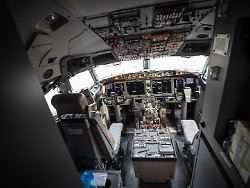Saturday 17th April 2021
Trouble with a breakdown plane again
New 737-Max problem bigger than expected
Last week, Boeing instructed several airlines not to continue operating the 737 Max crisis jet. The reason is a problem with the electrical system. It is now clear: the defect affects several areas of the cockpit.
Boeing’s problem with the electrics of the 737 Max aircraft, which recently caused a number of planes to be withdrawn from service, is more far-reaching than initially assumed. The causal production defects affect components in several areas of the cockpit, as the Airbus rival confirmed. Boeing is currently working with the airlines concerned on proposed solutions in order to submit them to the US aviation authority FAA.
A week ago, the aircraft manufacturer warned 16 customers of a potential defect and advised them to suspend the operation of certain versions of the 737 Max until possible defects in the power supply system can be ruled out. As a precaution, US airlines then removed dozens of planes from the flight plan. A solution has not yet been found – when the jets will be able to take off again remains unclear for the time being.
The 737 Max is Boeing’s best-selling model and a major profit maker. After two crashes with 346 deaths, the series was banned from flying for around 20 months and was not allowed to operate again in the USA until November. The reason for the accidents was considered to be defective control software. The current problems are not related to it, assures Boeing. In view of the tragic history, the focus is particularly on the model.
The fact that the problems with the electrics of numerous 737-Max machines are more extensive than initially thought was first reported on Friday by the specialist journal “Aviation Week”. As a result, around 460 jets are affected, but only 89 of them have been handed over to customers. Boeing has numerous machines in stock that were produced during the no-fly period but have not yet been delivered. The new defects could slow down the deliveries again.
The financial news agency Bloomberg reported, citing insiders, that solving the problem should be neither time-consuming nor complicated. Once the FAA approves Boeing’s plans, the work shouldn’t take more than a few days per aircraft, the report said. Investors reacted relatively calmly at first, Boeing’s shares came under a bit more pressure at times in late US trading, but ultimately only closed slightly in the red.
.
